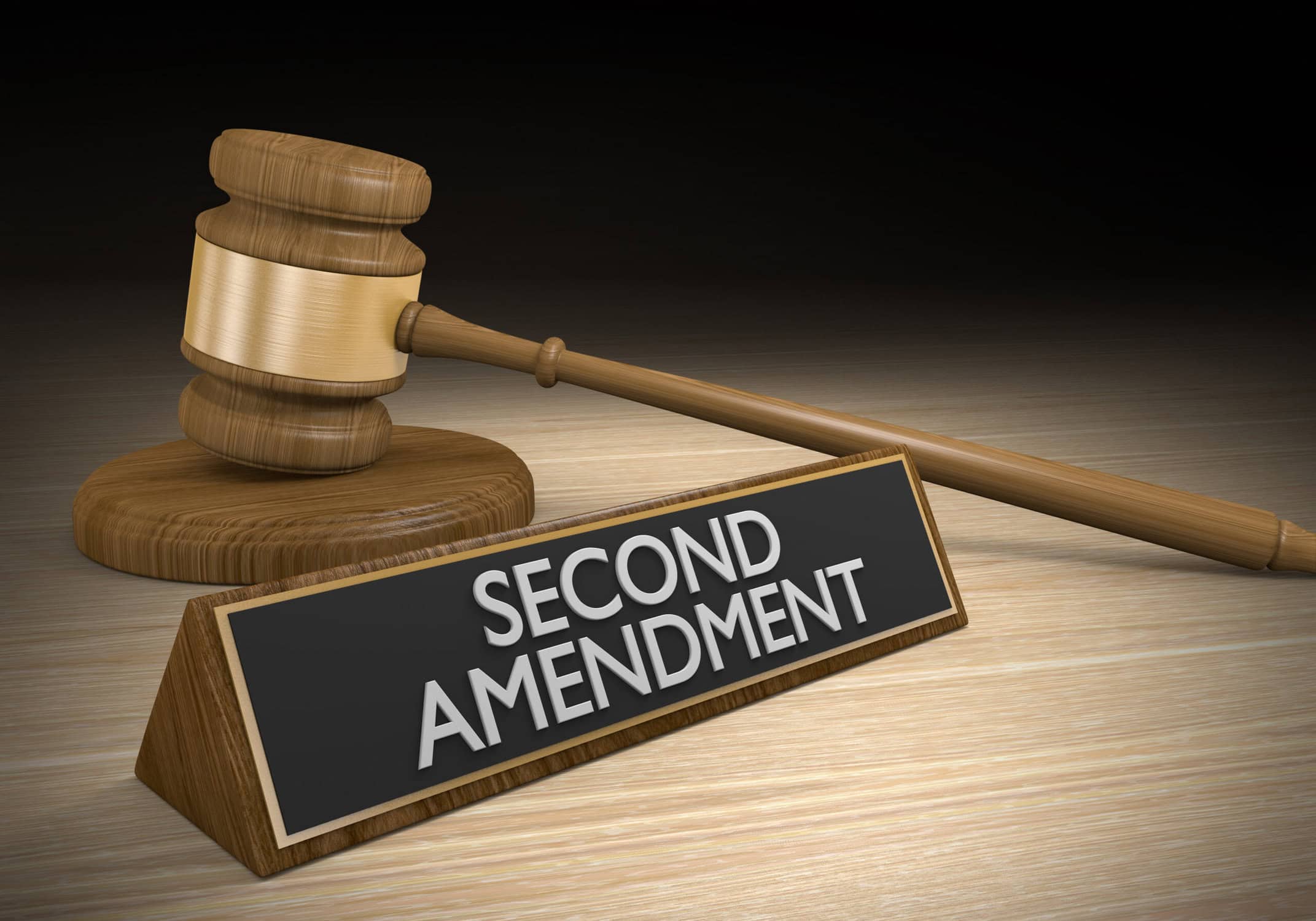C.D. Michel, Michel & Associates, P.C.

INTRODUCTION
In our 2021 article for California NORML, we discussed how federal gun laws intersect with California’s and other states legalization of recreational marijuana use. In that article, we examined Ninth Circuit authority holding that federal law makes it illegal for all marijuana users to possess a firearm.
Since then Second Amendment rights jurisprudence has developed rapidly. In June 2022, the Supreme Court issued its decision in New York State Rifle & Pistol Association v. Bruen. That ruling set forth the legal test that courts must apply when evaluating the constitutionality of laws regulating firearms and the people who can possess them. And it expressly rejected the analysis previously employed by the Ninth Circuit for deciding such cases. This year, the Court further elaborated on the Second Amendment analysis it established in Bruen with United States v. Rahimi, which confirmed that people deemed dangerous by a court can be disarmed.
Because some recent federal court rulings have held that the law prohibiting marijuana users from possessing firearms is unconstitutional, many have asked whether anything has changed legally for marijuana users who would choose to own a firearm.
The short answer is no. But that could change—and possibly soon.
This memo explains what has happened so far, what could happen next for marijuana users who would like to own a gun for sport or to defend themselves or their families, and how folks can reduce their vulnerability to prosecution.
THE NINTH CIRCUIT HAS CONFIRMED THAT FEDERAL LAW PROHIBITS MARIJUANA USERS FROM POSSESSING FIREARMS
Under 18 U.S.C. 922(g), it is unlawful for certain categories of people to “ship or transport in interstate or foreign commerce, or possess in or affecting commerce, any firearm or ammunition; or to receive any firearm or ammunition which has been shipped or transported in interstate or foreign commerce.”
One such category includes people that are “unlawful user[s] of or addicted to any controlled substance (as defined in section 102 of the Controlled Substances Act (21 U.S.C. 802)).” 18 U.S.C. 922(g)(3). Of course, the federal Controlled Substances Act still includes marijuana, effectively banning all current marijuana users from owning firearms or ammunition.
“Firearms” are defined by the law as “(A) any weapon (including a starter gun) which will or is designed to or may readily be converted to expel a projectile by the action of an explosive; (B) the frame or receiver of any such weapon; (C) any firearm muffler or firearm silencer; or (D) any destructive device.” 18 U.S.C.S. § 921(a)(3). So aside from prohibiting marijuana users from possessing firearms, federal law also prohibits users from possessing starter guns, firearm mufflers and silencers, and destructive devices (bombs, grenades, rockets, and so on).
“Ammunition” is defined by the law as “ammunition or cartridge cases, primers, bullets, or propellant powder designed for use in any firearm.” Id. § 921(a)(17)(A).
The Ninth Circuit has held that the firearm prohibition on cannabis users is constitutional, even in the context of those with medical marijuana cards, explaining that “these laws will sometimes burden—albeit minimally and only incidentally—the Second Amendment rights of individuals who are reasonably, but erroneously, suspected of being unlawful drug users. However, the Constitution tolerates these modest collateral burdens in various contexts, and does so here as well.” Wilson v. Lynch, 835 F.3d 1083, 1094-95 (9th Cir. 2016).
Thus, in the Ninth Circuit at least, even those with medical marijuana cards are essentially considered acceptable collateral damage to this overbroad government policy.
THE PROCESS OF BUYING A FIREARM
When anyone buys a firearm from or through a firearms retailer, they are required to answer questions on the federal “4473” form. In California, there are other state forms that must also be completed, including the Dealer Record of Sale (DROS) form.
The 4473 form specifically asks if the firearm purchaser is an “unlawful user” of marijuana. Even if marijuana use is legal in your state, it is still illegal under federal law. So to be truthful, you must answer “yes” to this question if you use marijuana.
The 4473 form must be signed under penalty of perjury. Committing perjury is a crime.
Federal law also expressly prohibits knowingly making any false statement on the 4473. Doing so is punishable by up to ten years in prison and up to a $250,000 fine. 18 U.S.C.S. § 924(b).
So if you don’t answer the questions on the 4473 form truthfully, you can be prosecuted under 18 U.S.C.S. § 924(a)(1)(A) for lying on the form. Prosecutors typically call these cases “Lie and Buy” cases.
A SUPREME COURT DECISION AND LEGAL GAME CHANGER
As a recent Associated Press article explained[1]
A landmark U.S. Supreme Court decision on the Second Amendment is upending gun laws across the country, dividing judges and sowing confusion over what firearm restrictions can remain on the books.
The high court’s ruling that set new standards for evaluating gun laws left open many questions, experts say, resulting in an increasing number of conflicting decisions as lower court judges struggle to figure out how to apply it.
The Supreme Court’s so-called Bruen decision changed the test that lower courts had long used for evaluating challenges to firearm restrictions. Judges should no longer consider whether the law serves public interests like enhancing public safety, the justices said.
Under the Supreme Court’s new test, the government that wants to uphold a gun restriction must look back into history to show it is consistent with the country’s “historical tradition of firearm regulation.”
Courts in recent months have declared unconstitutional federal laws designed to keep guns out of the hands of domestic abusers, felony defendants and people who use marijuana. Judges have shot down a federal ban on possessing guns with serial numbers removed and gun restrictions for young adults in Texas and have blocked the enforcement of Delaware’s ban on the possession of homemade “ghost guns.”
In several instances, judges looking at the same laws have come down on opposite sides on whether they are constitutional in the wake of the conservative Supreme Court majority’s ruling. The legal turmoil caused by the first major gun ruling in a decade will likely force the Supreme Court to step in again soon to provide more guidance for judges.
THE UNITED STATES v. HARRISON DECISION HOLDS THAT THE BAN ON FIREARMS POSSESSION BY MARIJUANA USERS IS UNCONSTITUTIONAL
The case of United States v. Harrison began on May 20, 2022, when Mr. Harrison was pulled over for running a red light. A loaded revolver was found in the car, along with a backpack with various marijuana products. A federal grand jury returned an indictment charging Harrison with possessing a firearm with knowledge that he was a marijuana user in violation of USC 18 U.S.C. § 922(g)(3). United States v. Harrison, No. 22-00328, 2023 U.S. Dist. LEXIS 18397 (W.D. Okla. Feb. 3, 2023).
Harrison asked the district court to dismiss the indictment on various grounds, including that § 922(g)(3), as applied to his marijuana use, violates the Second Amendment. Echoing what the Supreme Court ruled last year in Bruen, Harrison’s lawyers argued that the federal law barring marijuana users from possessing firearms conflicted with the nation’s historical tradition of firearm regulation.
The prosecution argued, on the other hand, that “disarming presumptively risky persons, namely, felons, the mentally ill, and the intoxicated” is in the public interest.
District Court Judge Patrick Wyrick disagreed, holding that the federal law depriving marijuana users of their Second Amendment rights is unconstitutional. He first explained that the federal government cannot simply exclude marijuana users from “the people” who have Second Amendment rights. If it could, he continued, then the power to exclude people from the protections that constitutional rights provide would be essentially limitless:
Frankly, it’s not even clear this is carving out a “subset,” as much as an outright declaration of the federal government’s belief that it can deprive practically anyone of their Second Amendment right. Who among us, after all, isn’t a “lawbreaker”? For sure, there may well exist some adult who has never exceeded the speed limit, changed lanes without signaling, or failed to come to a complete stop at a stop sign, but they are few and far between.
The government also argued that § 922(g)(3) was constitutional because it is analogous to the Nation’s deeply rooted historical tradition of disarming felons (because unlawful users of controlled substances have engaged in felonious conduct, even if not convicted of it yet). Again, Judge Wyrick disagreed:
Imagine a world where the State of New York, to end-run the adverse judgment it received in Bruen, could make mowing one’s lawn a felony so that it could then strip all its newly deemed “felons” of their right to possess a firearm. The label “felony” is simply “too easy for legislatures and prosecutors to manipulate.”
Judge Wyrick was also amused with the government’s response on this point:
Remarkably, when presented with this lawn-mowing hypothetical argument, and asked if such an approach would be consistent with the Second Amendment, the United States said “yes.” So, in the federal government’s view, a state or the federal government could deem anything at all a felony and then strip those convicted of that felony—no matter how innocuous the conduct—of their fundamental right to possess a firearm. Why? Because courts must defer to a legislature’s judgments about what is and is not a felony, says the United States. It’s as if Bruen’s command regarding the inappropriateness of such deference to legislative judgments has been lost in translation.
According to Judge Wyrick, the Nation’s historical tradition of regulating firearms supports disarming those who have shown their dangerousness through past violent, forceful, or threatening conduct. But a total prohibition on the right to possess a firearm merely because a person is a user of marijuana does not fall within that tradition. While the government made other arguments—including a bizarre effort to protect its law by analogizing to racist laws of the past (a move Wyrick called “concerning”)—ultimately it was this logic that led the court to rule as it did.
It bears repeating that all the United States would have to prove at trial in order to justify depriving Harrison of his right to possess a firearm is that he is a user of marijuana. But the mere use of marijuana carries none of the characteristics that the Nation’s history and tradition of firearms regulation supports. The use of marijuana—which can be bought legally (under state law) at more than 2,000 ordinary store fronts in Oklahoma—is not in and of itself a violent, forceful, or threatening act. It is not a “crime of violence.” Nor does it involve “the actual use or threatened use of force.”
That Congress may have passed § 922(g)(3), as the United States suggests, with some vague relation to public safety or “the public interest” does not change this conclusion. It is not appropriate for a court to “reflexively defer to a [legislative] label when a fundamental right is at stake.” And the use of marijuana does not become a violent, forceful, or threatening act merely because the legislature says it is.
Having established that marijuana users who possess firearms come within the plain text of the Second Amendment, Judge Wyrick proceeded to the historical analysis now required under Bruen. He noted that while there is some history of laws regulating firearm possession by intoxicated persons, none appear to have prohibited the possession of a firearm in the home for purposes of self-defense.
Where the seven laws the United States identifies took a scalpel to the right of armed self-defense—narrowly carving out exceptions but leaving most of the right in place—§ 922(g)(3) takes a sledgehammer to the right.
Judge Wyrick referenced the Bruen decision when he stated that marijuana use doesn’t make someone a “dangerous lunatic.”
But the United States’ own conception of the historical tradition demonstrates why §922(g)(3) as applied to Harrison is not analogous to these traditions. Under the United States’ own theory, history and tradition would limit disarmament to dangerous lunatics. And as explained above, the mere use of marijuana does not indicate that someone is in fact dangerous, let alone analogous to a “dangerous lunatic.” There are likely nearly 400,000 Oklahomans who use marijuana under state-law authorization. Lumping all those persons into a category with “dangerous lunatics,” as the United States’ theory requires, is a bridge too far.
Judge Wyrick also noted that the criminal justice system could have kept Harrison behind bars to ensure he didn’t get his hands on a gun if it concluded that he’s a threat.
None of this is to say that the government cannot play a role in protecting the public from dangerous persons possessing firearms. It can, and it should. For example, if the State of Texas thought that Harrison’s alleged involvement in a shooting demonstrated that Harrison was a danger to the public, it could have demonstrated to a Texas judge—in an individualized proceeding of which Harrison would have been given notice and the opportunity to be heard—that Harrison ought to be jailed while awaiting trial for that shooting. The Constitution, after all, permits pre-trial detention, and such detention would be a highly effective means of furthering the government’s interest in protecting the public from a gun-toting Harrison. But that didn’t happen; Harrison was released pending trial in Texas. And so here we are, with the federal government now arguing that Harrison’s mere status as a user of marijuana justifies stripping him of his fundamental right to possess a firearm. For all the reasons given above, this is not a constitutionally permissible means of disarming Harrison.
Judge Wyrick vacated the indictment against Harrison, dismissing it with prejudice. You can read the full ruling here.
In our opinion, the Harrison ruling properly applied the Bruen test. But many state and federal government authorities disagree. Indeed, the federal government appealed the district court decision, so the Tenth Circuit will be deciding on the constitutionality of the marijuana prohibition soon. You can track this appeal here.
UNDERSTANDING PERSUASIVE LEGAL AUTHORITY VS. MANDATORY LEGAL AUTHORITY
The ruling in Harrison was issued by the Western District of Oklahoma. A decision by one federal district court is not considered mandatory authority. So other district courts in Oklahoma (or anywhere else) are not bound by the decision, and they do not have to follow it.
Depending on how well-reasoned and well-written a district court ruling is, however, it can be considered persuasive authority, and the reasoning can be adopted voluntarily by any court.
The U.S. government has appealed the Harrison decision. Oklahoma is in the United States Court of Appeals for the Tenth Circuit, so decisions of the federal courts of Oklahoma are appealed to the Tenth Circuit. That may uphold or overturn the district court’s ruling. If upheld, any ruling (a win or a loss) from the Tenth Circuit would only be binding on federal courts within the Tenth Circuit. But again, such a decision could be relied on as persuasive authority in courts outside that circuit.
RULINGS BY OTHER COURTS
So far, two other court rulings have substantively discussed Harrison.
The first was not favorable. A district court in the Northern District of Indiana stated in a footnote:
The [c]ourt is not persuaded by Harrison in part due to the weight of authority reaching the contrary conclusion, the [c]ourt’s own analysis of the arguments presented in this case, and disagreements with the analysis and conclusions reached by the court in Harrison. For example, the [c]ourt would note that Harrison’s reasoning distinguishing the tradition of disarming dangerous persons from § 922(g)(3) seems reliant on reinterpreting those traditions based on pre-Bruen dissents from circuit decisions. See e.g., Harrison, No. 2:22-cr-328 at *31-*32, 2023 U.S. Dist. LEXIS 18397. The [c]ourt is not persuaded such a dramatic departure from existing precedent is required given Bruen established it was consistent with Heller, and the first step of the pre-Bruen test was also consistent with Heller. Bruen, 142 S.Ct. at 2127-30.
United States v. Posey, No. 2:22-CR-83, 2023 U.S. Dist. LEXIS 22005, at *24 n.9 (N.D. Ind. Feb. 9, 2023).
Things went better in the Western District of Texas, where the court cited Harrison repeatedly to support its conclusion that “Section 922(g)(3) breaks with historical intoxication laws by prohibiting not just firearm use by those who are actively intoxicated but also firearm possession by those who use controlled substances, even somewhat irregularly.” United States v. Connelly, No. EP-22-CR-229(2), 2023 U.S. Dist. LEXIS 62495, at *30 (W.D. Tex. Apr. 6, 2023).
The federal government appealed that ruling, but just recently, the Fifth Circuit affirmed, writing that while restrictions on a presently intoxicated person find historical support, “they do not support disarming a sober person based solely on past substance usage.” Like Judge Wyrick, the Fifth Circuit also rejected the government’s comparison to historical laws that restricted firearm access by the mentally ill. Thanks to this ruling, § 922(g)(3) will only be effective in the Fifth Circuit when it is applied to presently intoxicated people, and cannabis users are unaffected when they are not under the influence. And because it is a circuit court ruling, it has more persuasive value to courts in other circuits than the Harrison district court ruling does. Presumably, the federal government will petition the Supreme Court to review the case now, but it is unclear if that request will be granted.
It is likely that similar challenges will be brought in other district courts in other federal circuits, and those decisions will likely also be appealed. Ultimately, perhaps the Supreme Court will have to address this issue, particularly if two courts of appeal reach different conclusions. Indeed, because Harrison and Connelly are proceeding in different circuit courts, if different conclusions are reached by the respective circuits, the odds of Supreme Court review will increase. For example, if the Tenth Circuit reviewing the Harrison ruling ultimately disagrees with the Fifth Circuit’s recent ruling and upholds the federal law, then the Supreme Court will likely need to resolve the split. On the other hand, if the Tenth Circuit agrees with the district court in Harrison and the Fifth Circuit in Connelly, Supreme Court review may be less likely until another circuit court reaches a contrary ruling. That said, the more circuits that agree, the stronger the persuasive authority becomes, even without a Supreme Court ruling.
WHAT COMES NEXT?
For California marijuana users who choose to own a firearm to benefit, a similar challenge would have to be brought in a district court in the Ninth Circuit, which includes California. A district court ruling in California would likely be appealed to the Ninth Circuit—the same circuit that ruled in Wilson that federal law prohibits marijuana users from possessing firearms. Wilson v. Lynch, 835 F.3d 1083, 1094 (9th Cir. 2016). But that decision did not consider whether the ban itself violates the Second Amendment under Bruen. That is, the Ninth Circuit did not consider whether the ban was unconstitutional under our historical tradition of firearm regulation. Rather, it proceeded under the now-defunct tiered-scrutiny approach that gave the government far more deference.
There are legal battles being waged in Second Amendment challenges to various gun control laws across the country right now to determine how to apply Bruen when evaluating the constitutionality of any gun control law. Some of those cases challenge classifications of people who are prohibited by federal law from possessing firearms, like non-violent felons, certain misdemeanants, and people subject to civil restraining orders. Rulings in those cases might influence a court that is weighing the constitutionality of bans on firearm possession because of marijuana use.
TRY TO AVOID TROUBLE AND KNOW YOUR RIGHTS
Remember that if you are using marijuana and possess a firearm, you are breaking federal law.
If you have a medical marijuana card and you own firearms, that is evidence that can be used against you if the card is discovered, such as in an unrelated search. Even if you do not currently use marijuana, the government may assume otherwise if it learns you have such a card or other evidence of marijuana use.
The Bruen decision specifically addressed concealed carry permits, and what states could require from folks applying for one. The decision has made it much easier in all states, including California, to get one of these permits. But people who apply for a CCW are generally asked about drug use, and so forth. If you are not truthful in your application, you could face years in prison and hundreds of thousands of dollars in fines if the permit’s existence tips the government off that you are illegally in possession of firearms.
Further, while there is no crime specifically barring lying on a CCW permit application, the standard CCW application form is signed under penalty of perjury. If caught in a lie about marijuana use (or any other information asked on the form), you could be charged with perjury. Even if no such charges are brought, however, getting caught in such a lie would likely mean any future effort to get a CCW permit would be denied based on prior dishonesty.
Also keep in mind that you are vulnerable to being reported by anyone who knows this, and to police if they conduct an investigation for whatever reason. Although prosecuting people for this offense may not currently be high on the list of government priorities, if you possess a firearm and use marijuana, you are at risk right now. The politics of this issue could change.
Know your rights. Remain silent. Don’t incriminate yourself. Anything you say will be used against you, even if you are not read your rights first. Do not answer questions. Give your name and address only. Repeatedly say, “I want to remain silent and call my lawyer.” Do not discuss your case with police, friends, family, cellmates, or anyone but your lawyer. Beware: Police car and jail phone conversations are recorded and many in jail are informants.
Do not consent to give up your rights. A right voluntarily given up is a right lost. Do not be tricked, threatened, or persuaded into giving up your rights. Do not “consent” to a search without a search warrant. If asked for consent to search, politely and repeatedly refuse, and note nearby witnesses. Do not sign any statements without an attorney’s advice.
Ask for a lawyer. If arrested, you may be handcuffed, searched, photographed, and fingerprinted. Do not physically resist a search or arrest. You have a right to have an attorney present during any questioning. Once you say you want to remain silent and ask for a lawyer, questioning should stop. If they keep asking questions, keep silent and keep asking for your lawyer! Call and get your lawyer involved asap!
If you would like a free KNOW YOUR RIGHTS card with the above information to carry in your wallet, email our office at [email protected] and we can send you some.
[1] https://apnews.com/article/politics-mississippi-state-government-delaware-california-massachusetts-3983cecfd1107c263d5309ec0d80a966
Related Reading: NORML Legal Committee Submits Amicus Brief in Federal Case Challenging Government’s Gun Ban for Medical Cannabis Consumers 5/26/23
C.D. “Chuck” Michel is Senior Partner at the Long Beach Law firm of Michel & Associates, P.C. He is the author of California Gun Laws, A Guide to State and Federal Firearm Regulations now in its 10th edition for 2023 and available at www.calgunlawsbook.com.
Michel & Associates, P.C. is a California NORML legal committee member. See their listing in the Cannabis Attorneys directory.



